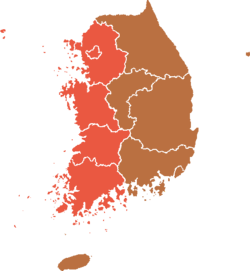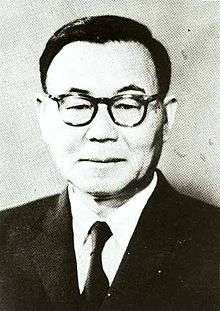South Korean presidential election, 1967
Republic of Korea presidential election, 1967

|
|
|
|
|

|
Map of pluralities won in provinces and cities:
■ – Park Chung Hee
■ – Yun Bo-seon |
|
|
Presidential elections were held in South Korea on 3 May 1967.[1] The result was a victory for Park Chung-hee, who won 51.4% of the vote. Voter turnout was 83.6%.[2]
Results
| Candidate |
Party |
Votes |
% |
|---|
| Park Chung-hee | Democratic Republican Party | 5,688,666 | 51.4 |
| Yun Bo-seon | New Democratic Party | 4,526,541 | 40.9 |
| Oh Chaeo-yong | Unification Korea Party | 264,533 | 2.4 |
| Kim Chun-yon | People's Party | 248,369 | 2.2 |
| Chon Chin-han | Korea Independence Party | 232,179 | 2.1 |
| Lee Se-chin | Justice Party | 98,433 | 0.9 |
| Invalid/blank votes | 586,494 | – |
| Total | 11,645,215 | 100 |
| Registered voters/turnout | 13,935,093 | 83.6 |
| Source: Nohlen et al |
By-province
| Province or city |
Park Chung Hee |
Yun Bo-seon |
Oh Jae-young |
Kim Jun-yeon |
Chun Jin-han |
Lee Se-jin |
Total |
|---|
| Votes |
% |
Votes |
% |
Votes |
% |
Votes |
% |
Votes |
% |
Votes |
% |
| Seoul |
595,513 |
(45.2%) |
675,716 |
(51.3%) |
11,447 |
(0.9%) |
13,142 |
(1.0%) |
14,242 |
(1.1%) |
7,635 |
(0.6%) |
1,317,695 |
|
| Gyeonggi |
525,676 |
(41.0%) |
674,964 |
(52.6%) |
22,383 |
(1.7%) |
23,248 |
(1.8%) |
25,306 |
(2.0%) |
11,029 |
(0.9%) |
1,282,606 |
|
| Gangweon |
429,589 |
(51.3%) |
349,807 |
(41.7%) |
18,211 |
(2.2%) |
17,757 |
(2.1%) |
15,400 |
(1.8%) |
7,310 |
(0.9%) |
838,074 |
|
| Chungnam |
489,516 |
(45.4%) |
505,076 |
(46.8%) |
17,662 |
(1.6%) |
27,295 |
(2.5%) |
28,809 |
(2.7%) |
10,560 |
(1.0%) |
1,078,918 |
|
| Chungbuk |
269,830 |
(46.6%) |
252,469 |
(43.6%) |
15,058 |
(2.6%) |
14,526 |
(2.5%) |
20,345 |
(3.5%) |
7,114 |
(1.2%) |
579,342 |
|
| Jeonnam |
652,847 |
(44.6%) |
682,622 |
(46.6%) |
42,249 |
(2.9%) |
46,721 |
(3.2%) |
28,156 |
(1.9%) |
11,774 |
(0.8%) |
1,464,369 |
|
| Jeonbuk |
392,037 |
(45.0%) |
451,611 |
(51.9%) |
21,527 |
(2.5%) |
23,945 |
(2.8%) |
28,943 |
(3.3%) |
8,325 |
(1.0%) |
870,344 |
|
| Busan |
338,135 |
(64.2%) |
164,077 |
(31.2%) |
9,922 |
(1.9%) |
6,866 |
(1.3%) |
4,556 |
(0.9%) |
3,028 |
(0.6%) |
526,584 |
|
| Gyeongnam |
838,426 |
(68.6%) |
281,545 |
(23.0%) |
45,325 |
(3.7%) |
30,740 |
(2.5%) |
16,065 |
(1.3%) |
9,895 |
(0.8%) |
1,221,996 |
|
| Gyeongbuk |
1,083,939 |
(64.0%) |
447,082 |
(26.4%) |
56,328 |
(3.3%) |
40,884 |
(2.4%) |
45,482 |
(2.7%) |
19,647 |
(1.2%) |
1,693,362 |
|
| Jeju |
73,158 |
(56.5%) |
41,572 |
(32.1%) |
4,421 |
(3.4%) |
3,245 |
(2.5%) |
4,875 |
(3.8%) |
2,116 |
(1.6%) |
129,387 |
|
References
- ↑ Dieter Nohlen, Florian Grotz & Christof Hartmann (2001) Elections in Asia: A data handbook, Volume II, p420 ISBN 0-19-924959-8
- ↑ Nohlen et al., p464













